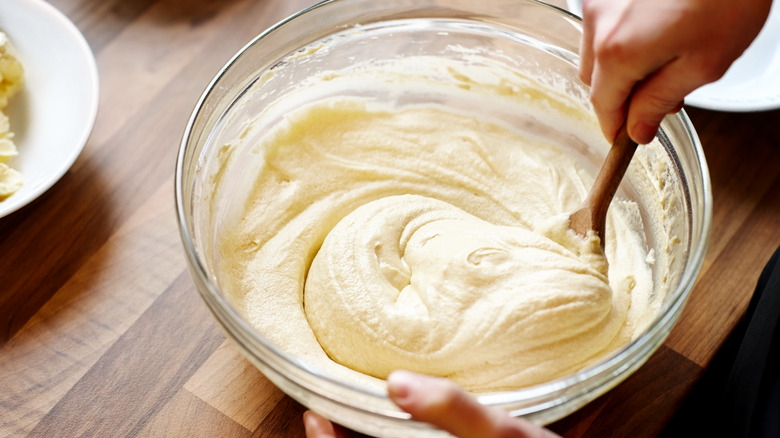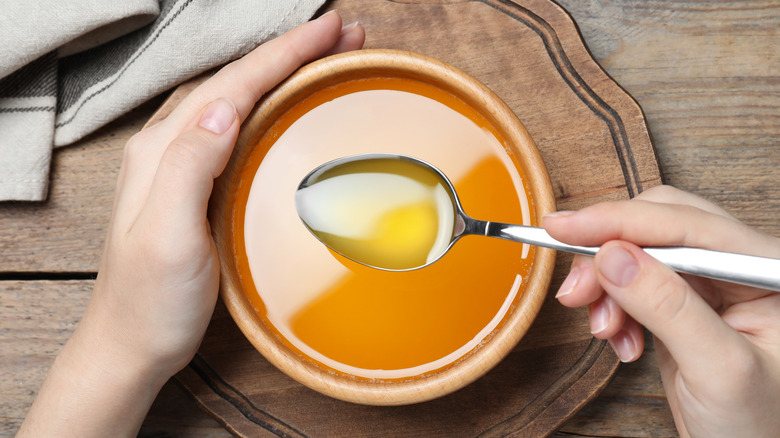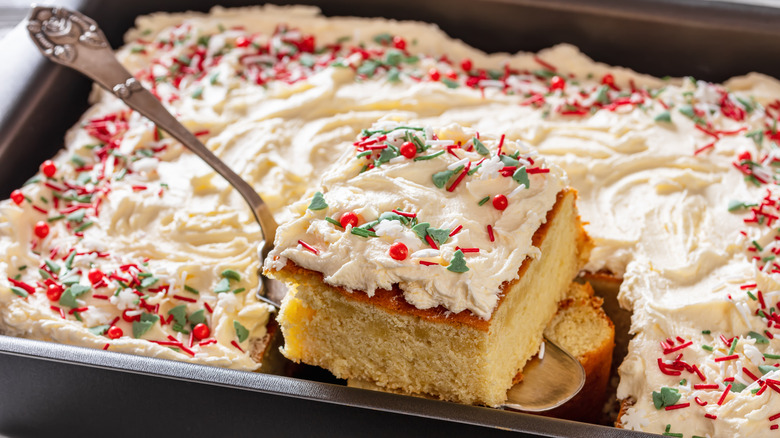Why You Should Skip The Vegetable Oil When Baking Boxed Cake Mix
Boxed cake mixes have certainly come a long way in recent years, allowing for convenient birthday celebration bakes and weeknight treats to be whipped up and thrown in the oven in a matter of minutes. Even with the best store-bought cake mixes, however, it's hard to match the taste and texture of a homemade cake. Many boxed cake mixes call for mixing pre-packaged and blended dry ingredients with water, vegetable oil, and eggs, which can result in cakes that do the job, but are a bit lacking in flavor. Luckily, we have a simple trick to easily elevate your boxed vanilla or red velvet cake mix: leave the vegetable oil behind and use a different fat instead.
Vegetable oil is an overarching name used to label a variety of plant oils, including canola, soybean oil, and corn oil. While these types of oils are widely available and usually quite cost-effective, they are typically refined, meaning they've undergone heating or chemical processing to result in flavorless, odorless oils, with high smoke points and longer shelf-lives compared to their unrefined counterparts.
While many cake mix recipes call for liquid fat in the form of vegetable oil, since the oil tastes neutral, there is a huge opportunity to add a depth of flavor to often bland, just-okay cake mixes. To impart extra flavor intrigue, simply opt for other more flavorful fats, such as melted butter, coconut oil, or olive oil.
Flavorful alternatives to vegetable oil
Instead of neutral-tasting vegetable oil, you can easily swap in melted unsalted butter or ghee, or unrefined liquid oils to result in a richer flavor profile for your boxed cake mix. Virgin or unrefined oils — like olive oil or pumpkin seed oil — can be used to amp up basic boxed cake mixes. Unrefined oils undergo minimal processing methods, such as cold-pressing or expeller-pressing, that are used just to extract the oil, as opposed to refined oils, which often use high heat and chemical solvents to deodorize, bleach, and remove other components from the oil. As a result, unrefined oils keep their unique flavor and aromatic properties and can really add to the taste of your cake.
When subbing out more flavorful butter or oils for your boxed cake mix, it's important to choose the right fat for the flavor of your cake. For instance, swap out vegetable oil for melted butter in our pink champagne cupcake recipe (which calls for white cake mix) to seriously elevate the rich, velvety undertones, or replace the vegetable oil with olive oil when making box mix lemon cake to boost the brightness of the acid and add extra nutty depth and savory flavor notes. You can also use melted unrefined coconut oil to impart a tropical flavor to your bakes (refined coconut oil will still carry some coconut flavor, for a more neutral coconut option).
How to swap out your fats
Alternative fats can be swapped out 1:1 most of the time to replace vegetable oil in baking mixes (meaning if your mix calls for half a cup of oil, simply use half a cup of melted butter). Olive oil and other flavorful liquid fats can be measured out and added right to the mix without any additional steps taken.
Prior to incorporating fats that are solid at room temperature, like butter or coconut oil, you'll need to melt them. Homemade cake recipes typically call for whipping butter with granulated sugar to trap tiny air bubbles and impart fluffiness in cakes, in a process called creaming. With boxed cakes, you can't cream the butter since the sugar is already blended into the mix. While melted butter won't offer the same fluffiness that creamed butter and sugar will, it will function similarly to liquid oil and add extra dairy-rich flavors to your box mix bakes.
Melt solid fats in a microwave-safe bowl in the microwave for about 30-45 seconds, checking at 15-second intervals, or melt your fat in a saucepan over low heat. Make sure to cool your fat slightly before adding it to your batter, so it doesn't partially cook the egg. Equally important, make sure that your other ingredients, like the eggs and milk, are at room temperature since some solid fats like coconut oil have a low melt point of 76 degrees Fahrenheit and can begin to clump or coagulate if brought below that temperature.


